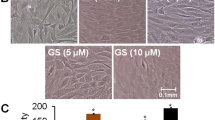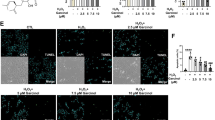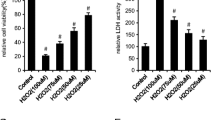Abstract
Osteocyte apoptosis due to microdamage and/or oxidative stress is related to increased local bone turnover and resorption observed in various bone diseases. Previous data on osteoblasts and osteoclasts have linked reactive oxygen species and antioxidants to bone remodelling. This study performs a comprehensive analysis on the effect of antioxidants such as glutathione (GSH), N-acetylcysteine and lipoic acid (LA) on starvation-induced osteocyte apoptosis and on cytokines involved in bone remodelling such as the receptor activator kB ligand (RANKL), osteoprotegerin (OPG) and sclerostin. For this study, apoptosis was induced by serum starvation in a murine osteocyte-like cell line MLO-Y4; this condition mimics in part osteocyte apoptosis due to microdamage. The results show that starvation-induced apoptosis and expression of RANKL, OPG and sclerostin are redox regulated processes. All antioxidants are able to inhibit the apoptosis due to starvation. They down-regulate the expression and the release of RANKL, the expression of sclerostin and RANKL/OPG ratio, whereas they only in part up-regulate OPG expression. Antioxidants mediate their effect on starvation-induced apoptosis by JNK signalling and on cytokine expression by both JNK and ERK1/2 activities. This study shows the possible involvement of biological antioxidants such as GSH and LA on redox regulated mechanisms related to apoptosis and expression of cytokines involved in bone remodelling. Moreover, it suggests that both JNK and ERK1/2 may be useful biological targets for drugs affecting bone diseases associated with increased oxidative stress.







Similar content being viewed by others
References
Bonewald LF, Johnson ML (2008) Osteocytes, mechanosensing and Wnt signalling. Bone 42:606–615
Henriksen K, Neutzsky-Wulff AV, Bonewald LF, Karsdal MA (2009) Local communication on and within bone controls bone remodelling. Bone 44:1026–1033
Bonewald LF (2011) The amazing osteocyte. J Bone Miner Res 26:229–238
Jilka RL, Noble B, Weinstein RS (2013) Osteocyte apoptosis. Bone 54:264–271
Verborgt O, Gibson GJ, Schaffler MB (2000) Loss of osteocyte integrity in association with microdamage and bone remodeling after fatigue in vivo. J Bone Miner Res 15:60–67
Hedgecock NL, Hadi T, Chen AA, Curtiss SB, Martin RB, Hazelwood SJ (2007) Quantitative regional associations between remodeling, modeling, and osteocyte apoptosis and density in rabbit tibial midshafts. Bone 40:627–637
Rochefort GY, Pallu S, Benhamou CL (2010) Osteocyte: the unrecognized side of bone tissue. Osteoporos Int 21:1457–1469
Noble B (2005) Microdamage and apoptosis. Eur J Morphol 42:91–98
Cardoso L, Herman BC, Verborgt O, Laudier D, Majeska RJ, Schaffler MB (2009) Osteocyte apoptosis controls activation of intracortical resorption in response to bone fatigue. J Bone Miner Res 24:597–605
Aguirre JI, Plotkin LI, Stewart SA et al (2006) Osteocyte apoptosis is induced by weightlessness in mice and precedes osteoclast recruitment and bone loss. J Bone Miner Res 21:605–615
Al-Dujaili SA, Lau E, Al-Dujaili H, Tsang K, Guenther A, You L (2011) Apoptotic osteocytes regulate osteoclast precursor recruitment and differentiation in vitro. J Cell Biochem 112:2412–2423
Tami AE, Nasser P, Verborgt O, Schaffler MB, Knothe Tate ML (2002) The role of interstitial fluid flow in the remodeling response to fatigue loading. J Bone Miner Res 17:2030–2037
Bai XC, Lu D, Bai J et al (2004) Oxidative stress inhibits osteoblastic differentiation of bone cells by ERK and NF-kappaB. Biochem Biophys Res Commun 314:197–207
Lean JM, Jagger CJ, Kirstein B, Fuller K, Chambers TJ (2005) Hydrogen peroxide is essential for estrogen-deficiency bone loss and osteoclast formation. Endocrinology 146:728–735
Jun JH, Lee SH, Kwak HB et al (2008) N-acetylcysteine stimulates osteoblastic differentiation of mouse calvarial cells. J Cell Biochem 103:1246–1255
Romagnoli C, Marcucci G, Favilli F et al (2013) Role of GSH/GSSG redox couple in osteogenic activity and osteoclastogenic markers of human osteoblast-like SaOS-2 cells. FEBS J 280:867–879
Banfi G, Iorio EL, Corsi MM (2008) Oxidative stress, free radicals and bone remodelling. Clin Chem Lab Med 46:1550–1555
Mann V, Huber C, Kogianni G, Collins F, Noble B (2007) The antioxidant effect of estrogen and selective estrogen receptor modulators in the inhibition of osteocyte apoptosis in vitro. Bone 40:674–684
Kikuyama A, Fukuda K, Mori S, Okada M, Yamaguchi H, Hamanishi C (2002) Hydrogen peroxide induces apoptosis of osteocytes: involvement of calcium ion and caspase activity. Calcif Tissue Int 71:243–248
Finkel T, Holbrook NJ (2000) Oxidants, oxidative stress and the biology of ageing. Nature 408:239–247
Nicks KM, Amin S, Atkinson EJ, Riggs BL 3rd, Melton LJ, Khosla S (2012) Relationship of age to bone microstructure independent of areal bone mineral density. J Bone Miner Res 27:637–644
Bjelaković G, Beninati S, Pavlović D et al (2007) Glucocorticoids and oxidative stress. J Basic Clin Physiol Pharmacol 18:115–127
Weinstein RS, Nicholas RW, Manolagas SC (2000) Apoptosis of osteocytes in glucocorticoid-induced osteonecrosis of the hip. J Clin Endocrinol Metab 85:2907–2912
Sendur OF, Turan Y, Tastaban E, Serter M (2009) Antioxidant status in patients with osteoporosis: a controlled study. Joint Bone Spine 76:514–518
Hall SL, Greendale GA (1998) The relation of dietary vitamin C intake to bone mineral density: results from the PEPI study. Calcif Tissue Int 63:183–189
Sanders KM, Kotowicz MA, Nicholson GC (2007) Potential role of the antioxidant N-acetylcysteine in slowing bone resorption in early post-menopausal women: a pilot study. Transl Res 150:215
Franco R, Schoneveld OJ, Pappa A, Panayiotidis MI (2007) The central role of glutathione in the pathophysiology of human diseases. Arch Physiol Biochem 113:234–258
Byun CH, Koh JM, Kim DK, Park SI, Lee KU, Kim GS (2005) Alpha-lipoic acid inhibits TNF-alpha-induced apoptosis in human bone marrow stromal cells. J Bone Miner Res 20:1125–1135
Koh JM, Lee YS, Byun CH et al (2005) Alpha-lipoic acid suppresses osteoclastogenesis despite increasing the receptor activator of nuclear factor kappaB ligand/osteoprotegerin ratio in human bone marrow stromal cells. J Endocrinol 185:401–413
Ballatori N, Krance SM, Notenboom S, Shi S, Tieu K, Hammond CL (2009) Glutathione dysregulation and the etiology and progression of human diseases. Biol Chem 390:191–214
Yan W, Li N, Hu X et al (2013) Effect of oral ALA supplementation on oxidative stress and insulin sensitivity among overweight/obese adults: a double-blinded, randomized, controlled, cross-over intervention trial. Int J Cardiol 167:602–603
Smith AR, Shenvi SV, Widlansky M, Suh JH, Hagen TM (2004) Lipoic acid as a potential therapy for chronic diseases associated with oxidative stress. Curr Med Chem 11:1135–1146
Mainini G, Rotondi M, Di Nola K et al (2012) Oral supplementation with antioxidant agents containing alpha lipoic acid: effects on postmenopausal bone mass. Clin Exp Obstet Gynecol 39:489–493
Mulcahy LE, Taylor D, Lee TC, Duffy GP (2011) RANKL and OPG activity is regulated by injury size in networks of osteocyte-like cells. Bone 48:182–188
Bellido T (2014) Osteocyte-driven bone remodelling. Calcif Tissue Int 94:25–34
Circu ML, Aw TY (2010) Reactive oxygen species, cellular redox systems, and apoptosis. Free Radic Biol Med 48:749–762
Circu ML, Aw TY (2012) Glutathione and modulation of cell apoptosis. Biochim Biophys Acta 1823:1767–1777
Plotkin LI, Aguirre JI, Kousteni S, Manolagas SC, Bellido T (2005) Bisphosphonates and estrogens inhibit osteocyte apoptosis via distinct molecular mechanisms downstream of extracellular signal-regulated kinase activation. J Biol Chem 280:7317–7325
Marathe N, Rangaswami H, Zhuang S, Boss GR, Pilz RB (2012) Pro-survival effects of 17β-estradiol on osteocytes are mediated by nitric oxide/cGMP via differential actions of cGMP-dependent protein kinases I and II. J Biol Chem 287:978–988
Kogianni G, Mann V, Ebetino F et al (2004) Fas/CD95 is associated with glucocorticoid-induced osteocyte apoptosis. Life Science 75:2879–2895
Kato Y, Windle JJ, Koop BA, Mundy GR, Bonewald LF (1997) Establishment of an osteocyte-like cell line, MLO-Y4. J Bone Miner Res 12:2014–2023
Kalajzic I, Matthews BG, Torreggiani E, Harris MA, Divieti Pajevic P, Harris SE (2013) In vitro and in vivo approaches to study osteocyte biology. Bone 54:296–306
Vincent C, Findlay DM, Welldon KJ et al (2009) Pro-inflammatory cytokines TNF-related weak inducer of apoptosis (TWEAK) and TNFalpha induce the mitogen-activated protein kinase (MAPK)-dependent expression of sclerostin in human osteoblasts. J Bone Miner Res 8:1434–1449
Bakker A, Klein-Nulend J, Burger E (2004) Shear stress inhibits while disuse promotes osteocyte apoptosis. Biochem Biophys Res Commun 320:1163–1168
Yang W, Harris MA, Heinrich JG, Guo D, Bonewald LF, Harris SE (2009) Gene expression signatures of a fibroblastoid preosteoblast and cuboidal osteoblast cell model compared to the MLO-Y4 osteocyte cell model. Bone 44:32–45
Papanicolaou SE, Phipps RJ, Fyhrie DP, Genetos DC (2009) Modulation of sclerostin expression by mechanical loading and bone morphogenetic proteins in osteogenic cells. Biorheology 46:389–399
Kennedy OD, Laudier DM, Majeska RJ, Sun HB, Schaffler MB (2014) Osteocyte apoptosis is required for production of osteoclastogenic signals following bone fatigue in vivo. Bone 64:132–137
Acknowledgments
We would like to thank Dr. Lynda Bonewald for the MLO-Y4 cells and the careful reading and review of the manuscript. This study was supported by grants from the Ministero dell’Istruzione, dell’Università e della Ricerca and Fondazione Cassa di Risparmio di Firenze.
Conflict of interest
Vincenzini, Fontani, Marcucci, Iantomasi, Brandi have nothing to disclose.
Human and Animal Rights and Informed Consent
This article does not contain any studies with human or animal subjects performed by any of the authors.
Author information
Authors and Affiliations
Corresponding author
Rights and permissions
About this article
Cite this article
Fontani, F., Marcucci, G., Iantomasi, T. et al. Glutathione, N-acetylcysteine and Lipoic Acid Down-Regulate Starvation-Induced Apoptosis, RANKL/OPG Ratio and Sclerostin in Osteocytes: Involvement of JNK and ERK1/2 Signalling. Calcif Tissue Int 96, 335–346 (2015). https://doi.org/10.1007/s00223-015-9961-0
Received:
Accepted:
Published:
Issue Date:
DOI: https://doi.org/10.1007/s00223-015-9961-0




